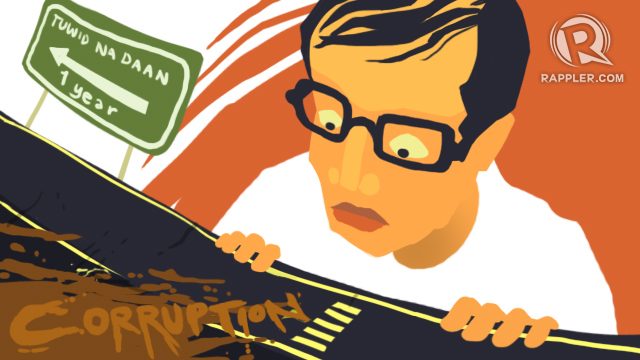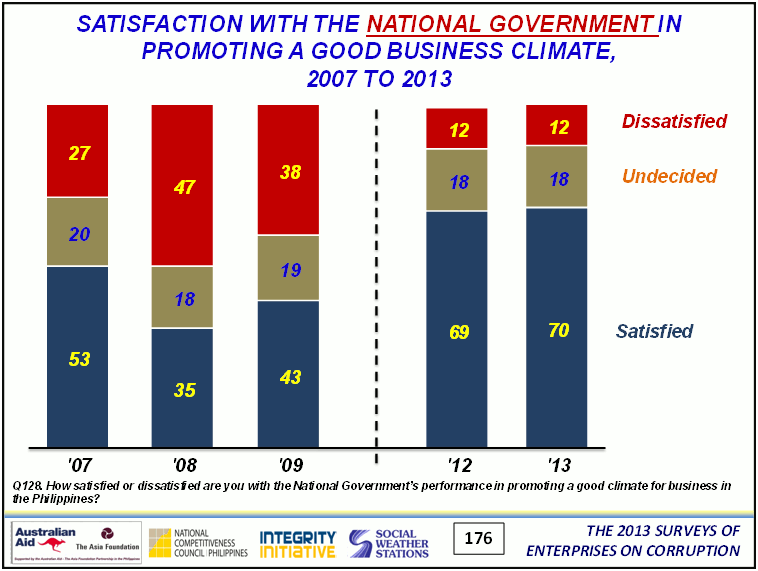SUMMARY
This is AI generated summarization, which may have errors. For context, always refer to the full article.

MANILA, Philippines – Since he was elected in 2010, President Benigno Aquino III carried with him a tuwid na daan (straight path) slogan that defined his government’s drive to fight corruption.
Under his administration, a string of corruption issues were exposed, including the undeclared wealth of former Supreme Court chief justice Renato Corona, the abuses of Janet Napoles, and the misuse of lawmakers’ pork barrel funds.
Other issues put the government in a bad light, such as the Disbursement Acceleration Program (DAP) and the reported delay in the response to Super Typhoon Yolanda victims.
But how do we rate the anti-corruption campaign of the present administration?
Rappler looked at various data and surveys that tried to measure and assess the Aquino administration’s campaign. Below are some of them:
1. Sandiganbayan data
The Sandiganbayan is a key player in the administration’s anti-corruption drive, as it handles and decides on corruption cases against government officials and employees. (READ: Get to know the anti-graft court Sandiganbayan)
The Aquino administration has witnessed an increasing number of case loads for the Sandiganbayan (in terms of cases filed or revived) through the years – more than those in the past administrations.
In previouos administrations too, the number of cases that ended up undecided by year-end remained high. In fact, the disposal rate of the Sandiganbayan cases under the Aquino government never exceeded 20%.
The lowest under the current administration was in 2014, when only 8.22% of all cases before the Sandiganbayan were decided upon.
Former Ombudsman Simeon Marcelo said that the disposition of cases in the Sandiganbayan has been snail-paced even before, and has become worse in recent times.
He said that in 2002, it took an average of 6.6 years for the Sandiganbayan to complete a case – from the filing of charges to the release of a verdict. A decade after, it takes an average of 10.2 years to process cases.
He suggested fixing the bottleneck in the Sandiganbayan if government is to win the war against corruption.
The Sandiganbayan, on the other hand, pointed to the Ombudsman for “inordinate delays” which have forced them to dismiss some cases. It even issued a resolution in November 2014, describing the delays as “deplorable” and as grossly offending “the right of public justice.”
In a move to speed up deliberations and hearings of cases in the Sandiganbayan, Aquino signed in April 2015 Republic Act 10660, expanding the number of divisions in the anti-graft court from 5 to 7.
Among the 14 incumbent Sandiganbayan justices, 6 are Aquino appointees: Presiding Justice Amparo M. Cabotaje-Tang and Associate Justices Maria Cristina Cornejo, Rafael Lagos, Oscar Herrera Jr, Ma. Theresa Gomez-Estoesta, and Sarah Jane Fernandez.
2. International assessment
While the Sandiganbayan records show poor figures, assessments by international organizations, on the other hand, present a better picture.
Both the World Bank and the Transparency International have been giving high scores to the Aquino administration – in fact, improving through the years – in their Worldwide Governance Indicators for Control of Corruption (WGI-CC) and Corruption Perception Index (CPI), respectively.
The WGI-CC measures “perceptions of the extent to which public power is exercised for private gain, including both petty and grand forms of corruption, as well as “capture” of the state by elites and private interests.”
The CPI, on the other hand, measures a contry’s “perceived levels of corruption, as determined by expert assessments and opinion surveys.”
These scores are important indicators, as they reflect the attractiveness of the country’s business climate for investors.
Why the improving scores? In a statement released in 2014, the Investor Relations Office (IRO) of the Bangko Sentral ng Pilipinas explained: “The improvement in the Philippines’ ranking came with the Aquino administration’s sustained reform agenda, which includes transparency in the budget process and efforts to cleanse government agencies perceived to suffer from corruption.”
3. Public surveys
But how about perceptions at home?

The trend in the country’s scores in the WGI-CC and CPI somehow match the responses in the Social Weather Stations (SWS) surveys on corruption, especially the part where respondents were asked: “How satisfied or dissatisfied are you with the National Government’s performance in promoting a good climate for business in the Philippines?”
The survey results reveal that more people were “satisfied” in the 2012 and 2013 surveys compared to those who gave the same response in the 2007, 2008, and 2009 surveys. Also, the number of respondents who replied “dissatisfied” in the last two surveys dropped to almost half of those in the previous 3 surveys. (See chart on the left)
Responses in the Pulse Asia surveys on corruption, however, show a different trend. When it surveyed how the public perceives the Aquino administration’s actions on different issues, high scores were initially given to “fighting graft and corruption in government.”
Scores for this item declined, however, as issues of corruption started to hit the administration.
Aquino’s approval ratings for “fighting graft and corruption in government” began to drop in 2013, right after obtaining the highest rating (65%) in the November 2012 survey.
Among the issues raised against the administration in 2013 were the reported slow government response to the needs of Super Typhoon Yolanda victims, and the Palace’s defense of its controversial DAP.
The same declining trend is evident in the January 19-30, 2015 survey of IBON Foundation, which revealed that more than half believe that the level of corruption in the country “in the past 3 months” hasn’t decreased.
“Critics have pointed out that the Aquino administration’s drive against corruption lacks genuine reforms, including holding accountable several administration allies involved in anomalies,” Ibon said.
This could be a reference to the failure of Aquino to exact accountability from his close friend, former Philippine National Police chief Alan Purisima, over the failed Mamasapano operation that left 44 elite cops dead in January 2015. Purisima was also previously suspended for graft charges but was never fired by the President. He accepted Purisima’s resignation only in February 2015.
The justice department likewise has yet to file a third batch of cases involving administration allies who misused their Priority Development Assistance Fund or pork barrel. – Rappler.com
Add a comment
How does this make you feel?
There are no comments yet. Add your comment to start the conversation.